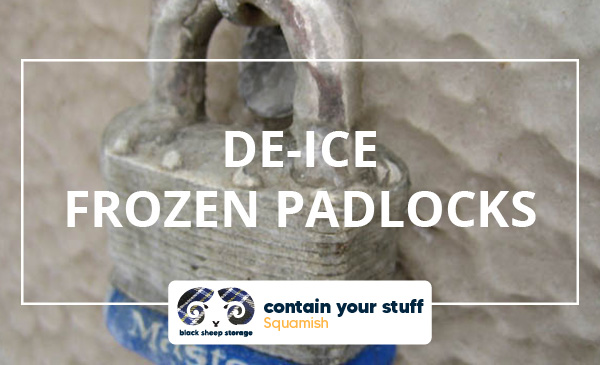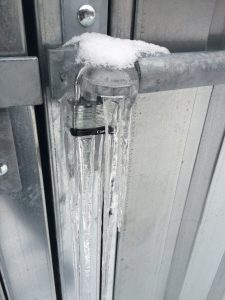As liquid moisture seeps into the holes, gaps and crevices of a padlock, this can cause it to turn into solid ice during cold winter temperatures. Which is a problem when the lock needs to be opened. Luckily, there are some crafty resolutions in thawing out a padlock. Contain Your Stuff Squamish recommends using just a few household items, you can de-ice your padlock safely and with ease.
How to De-Ice Your Frozen Padlock
- Pour some hand sanitizer onto the key and try to insert as much hand sanitizer into the lock as possible. Insert the key and unlock the padlock. If the padlock remains frozen, repeat the steps. Hand sanitizer contains alcohol, which can melt the ice. Only in high concentrations’ alcohol can burn, however the intensity used in hand sanitizers is not high enough to burn, but enough to assist in thawing.
- Hold the key by the end and light the key with a lighter or a match to heat it. Move the flame back and forth to heat as much of the key as possible. Direct the flame towards the keyhole to melt the ice in the opening for a few seconds. Insert the heated key into the padlock and try to open it without forcing it. This step is usually successful after a few attempts. Repeat these techniques as necessary to thaw the lock. Warning: Be careful with the flame and the heat. As you’re heating the key do not burn your fingers, melt any plastic attachment the key may have or allow the key to become so hot that it’s painful to even hold.
- Spray deicer solution directly into the lock, this will help melt the ice and free up the locking mechanisms. This method could take 5–10 minutes to unfreeze. Insert the key and unlock the padlock. Commercial De-Icers are specially formulated for these purposes, so please follow any additional product instructions, if needed.
- Apply a small portion of petroleum jelly onto the key. Insert the key inside the padlock and see if you can move or turn the key sufficiently to spread some of the jelly into the interior of the padlock without forcing the key, as it’ll break. Repeat the process as needed to open the padlock, allowing a few minute breaks between each step. The jelly will melt the ice inside the lock.
- If you have no warm water or antifreeze, then you’re simply going to have to get your hands cold. The heat from our hands is sometimes warm enough to thaw the ice. Place hands around the lock for about a minute. This is sometimes enough to melt the ice, so the key can be inserted. Do not perform this with bare hands, or you might find your hands stuck to the lock. If you don’t have gloves, place a cloth or some kind of material over the lock and hold it until it thaws out. It takes approximately 5–15 minutes, depending on how much water got into the padlock.
If you have any problems with your storage unit padlocks, contact us today.










